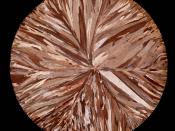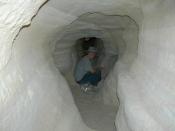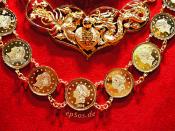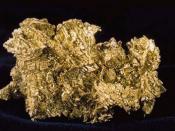Metallurgy is a domain of materials science that studies the physical and chemical behavior of metallic elements, their inter-metallic compounds, and their mixtures, which are called alloys. It is also the technology of metals: the way in which science is applied to their practical use. Metallurgy is commonly used in the craft of metalworking.
GOLDGold is found and mined extensively and is usually used as jewelry for women in making of bracelets, trinkets, etc. in early days gold was usually pure when it was used to concoct significant items. This led to the ancient ways of naming metals. Therefore the early gold varied in their forms and this way gold was named Au from the Latin name Aurum meaning SHINING DAWN.
Stone Age man learned to fashion gold into jewelry and ornaments, learning that it could be formed into sheets and wires easily. However, its malleability, which allows it to be formed into very thin sheet (0.000005
inches), ensures that it has no utilitarian value and early uses were only decorative. As gold is a noble metal, being virtually no corrosive and tarnish free, it served this purpose admirably.
Gold is usually dispersed through the earthÃÂs crust and is found in two types of deposits. In the lode deposits are usually found in the solid crust of the earth are usually mined conventional mining techniques. The deposit areas were mostly found in stream beds and the in the products of eroding lode deposits. Since then gold has literally left nature and found solace in stream beds. This is as many early gold smiths would collect nuggets of gold in their surrounding stream beds and would weld them together by hammering to form chain mail, cross guards, etc. During the process the heated metals would be identified as most of them were mixed with rocks, stones, gravel and dirt. This mad the process long and annoying making gold one of the most difficult metal to work with. Gold is widely dispersed throughout the earths crust (0.005 ppm) at a very small level; therefore, it is very important to find naturally occurring concentrations. The scarcity of gold and its value, due to mankindÃÂs fascination with its color, have lead to gold being the one of the most important metals in daily life.
ADVANTAGESThe mining of gold is a long and tedious process. However the results that the miners yield are large amounts of gold. As it is valuable like many other commodities(oil, coal, iron, lead, etc) many people buy it for fashion, gifts, etc. Also it has very few industrial uses making it a commodity which factories may not use.Its primary use is decorative (jewelry). Other than that it is used in computers, TVs, and other electronics in minute amounts.
DISADVANTAGESGold mining unlike coal or deep mineral mining does not help to trigger earthquakes or the formation of volcanoes. However the mining causes much pollution and the gold ore is generally bad for the surrounding environment. Also to remove large, unmovable rocks dynamites and bombs are used to blast them out of the way which may cause serious injury. Gold is unique in that cyanide is frequently used to extract the metal from the rock through a process called heap leaching..To get the last bit of gold they pile the waste ore on top of thick sheets of plastic then start spraying it with cyanide. They collect the fluid at the bottom then process it further to extract the gold that has bonded to the cyanide. The waste fluid is quite hazardous to human lungs and also to many animals which live in the surrounding areas. .
SILVERAlthough silver was abundant and found freely in nature the occurrence or discovering of it was rather rare. It is the most chemically active of the noble metals and is harder than gold yet softer than copper. It ranks second in ductility and malleability to gold. It is stable in pure air and water but starts corroding when exposed to hydrogen sulfide, ozone or sulfur. Due to its malleability and softness it was used in ornaments and jewelry and signified wealth in the old days. Now however silver is given to many people as a sign of friendship or love. Silver's symbol is Ag from the Latin argentums.
COPPERThe use of copper as increased in the past centuries. In the old days it was in antiquity and had much more importance than gold as most of the weapons were constructed by copper. From 4,000 to 6,000 BC was the Chalcolithic period which was when copper came into common use. The symbol for copper is Cu and comes from the Latin cuprum meaning from the island of Cyprus. Copper was usually broken into small pieces before construction but when it was hammered it became very brittle and would easily break. The solution to copper was found before 5000 BC in which the pieces of copper were dropped in the camp fires and then hammered down.
By 3600 BC the first copper smelted artifacts were found in the Nile valley and copper rings, bracelets, chisels were found. By 3000 BC weapons, tools etc. were widely found. Tools and weapons of utilitarian value were now within society, however, only kings and royalty had such tools; it would take another 500 years before they reached the peasants.
However copper can be found free in nature like most sources such as Cuprite, Malachite, Azurite, Chalcopyrite and Bornite. Copper is reddish colored, malleable, ductile and a good conductor of heat and electricity. Approximately 90% 0f the worldÃÂs primary copper originates in sulfide ores.
LEADLead is not found easily in nature yet the ancient Egyptians used Galena (lead sulfide) as an eye paint. Galena has a metal like appearance and as a common choice for early metal workers. The production of metallic lead from its ore is relatively easy and could have been produced by reduction of Galena in a camp fire. The melting point of lead is 327 C; therefore, it would easily flow to the lowest point in the fireplace and collect.
However in the beginning it was not used as it was too ductile and was only used around 3500 BC. Lead was an excellent container and the Roman pipes usually bore the Lead insignia. It is highly malleable, ductile and no corrosive making it an excellent piping material. Its symbol is Pb from the Latin plumbum.
The ability of lead to find the hottest temperature in the fire is a important concept in the metallurgy process as the reduction reactions were useful in the phase separation. Also the phase separation should also enable the metal to be cast into a desired shape once concentrated.
BIBLIOGRAPHYÃÂhttp://www.historyworld.net/wrldhis/PlainTextHistories.asp?historyid=ab16ÃÂhttp://neon.mems.cmu.edu/cramb/Processing/history.htmlÃÂhttp://www.hyperhistory.net/apwh/essays/cot/t0w03metaluses.htmÃÂhttp://ezinearticles.com/?Metal-Buildings-and-Their-Advantages&id=653527ÃÂhttp://www.advantagerecycling.com/





